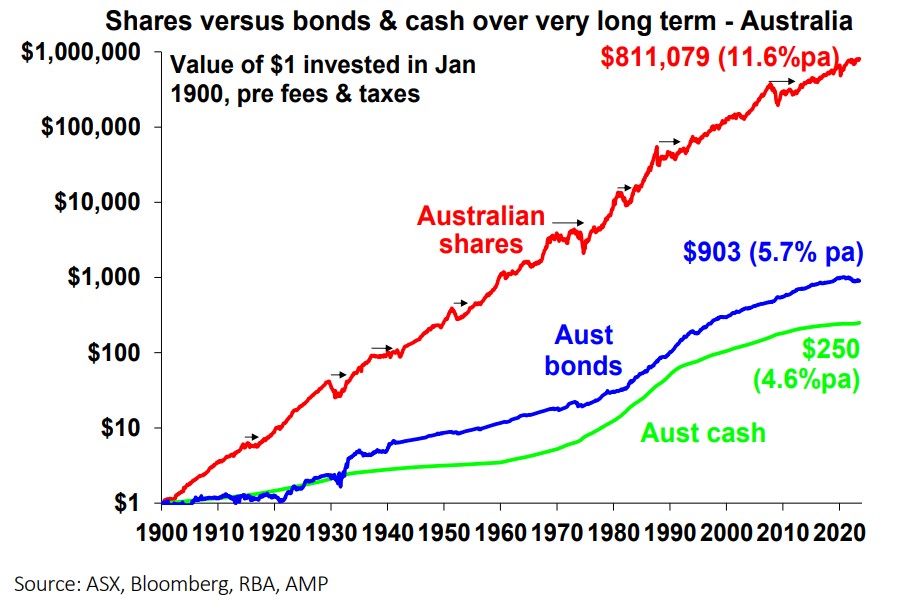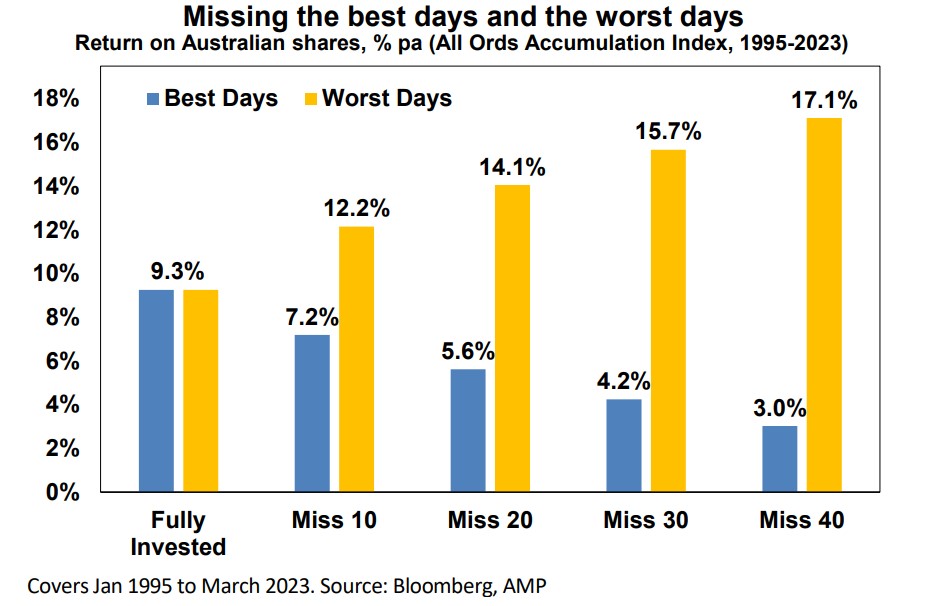Three reasons to err on the side of optimism as an investor
Consistent with this, it seems that the worry list for investors is more threatening and confusing. This was an issue prior to coronavirus – with trade wars, social polarisation, tensions with China, worries about job loss from automation and ever-present predictions of a new financial crisis.
Three reasons why worries might seem more worrying
There is no denying there are things to worry about at present – notably inflation, political polarisation, less rational policy making and geopolitical tensions - and that these may result in more constrained investment returns. But there is a psychological aspect to this combining with greater access to information and the rise of social media to magnify perceptions around worries. All of which may be adding to a sense of pessimism.
Humans tend to suffer from a behavioural trait known as "loss aversion" in that a loss in financial wealth is felt much more negatively than the positive impact of the same sized gain. This probably reflects the evolution of the human brain in the Pleistocene age when the key was to avoid being eaten by a sabre-toothed tiger or squashed by a wholly mammoth. This left the human brain hard wired to be on guard against threats and naturally risk averse. So, we are more predisposed to bad news stories as opposed to good.
Consequently, bad news and doom and gloom find a more ready market than good news or balanced commentary as it appeals to our instinct to look for risks.
Hence the old saying “bad news and pessimism sells”. This is particularly true as bad news shows up as more dramatic whereas good news tends to be incremental. Reports of a plane (or a share market) crash will be far more newsworthy (generating more clicks) than reports of less plane crashes this decade (or a gradual rise in the share market) ever will. As a result, prognosticators of gloom are more likely to be revered as deep thinkers than optimists.
As English philosopher and economist John Stuart Mill noted “I have observed that not the man who hopes when others despair, but the man who despairs when others hope, is admired by a large class of persons as a sage.”
Secondly, we are now exposed to more information on everything, including our investments.
We can now check facts, analyse things, sound informed easier than ever. But for the most part we have no way of weighing such information and no time to do so. So, it’s often noise.
As Frank Zappa noted “Information is not knowledge, knowledge is not wisdom.” This comes with a cost for investors. If we don't have a process to filter it and focus on what matters, we can suffer from information overload. This can be bad for investors as when faced with more (and often bad) news we can freeze up and make the wrong decisions with our investments.
Our natural “loss aversion” can combine with what is called the “recency bias” – that sees people give more weight to recent events in assessing the future – to see investors project recent bad news into the future and so sell after a fall.
As famed investor Peter Lynch observed “Stock market news has gone from hard to find (in the 1970s and early 1980s), then easy to find (in the late 1980s), then hard to get away from.”
We are now bombarded with economic and financial news and opinions with 24/7 coverage by multiple web sites, subscription services, finance updates, dedicated TV and online channels, chat rooms and social media.
Google the words “the coming financial crisis” and it’s teeming with references – 270 million search results at present – and as you might expect many of the titles are alarming:
- "A recession worse than 2008? How to survive and thrive."
- "Could working from home cause the next financial crisis"
- "Economic crash in inevitable"
- "Three men predicted the last financial crisis - what they're warning of now is terrifying."
- "How China's debt problem could trigger a financial crisis"
People have always been making gloomy predictions of “inevitable” and
“imminent” economic and/or financial disaster but prior to the
information explosion and social media it was much harder to be regularly
exposed to such disaster stories. The danger is that the combination of
the ramp up in information and opinion, combined with our natural
inclination to zoom in on negative news, is making us worse investors:
more distracted, pessimistic, jittery and focused on the short-term.
Three reasons to be optimistic as an investor
There are 3 good reasons to err on the side of optimism as an investor.
Firstly, without a degree of optimism there is not much point in investing.
As the famed value investor Benjamin Graham pointed out: “To be an investor you must be a believer in a better tomorrow.” If you don’t believe the bank will look after your deposits, that most borrowers will pay back their debts, that most companies will see rising profits over time supporting a return to investors, that properties will earn rents, etc, then there is no point investing. To be a successful investor you need to have a reasonably favourable view about the future.
Secondly, the history of share markets(and other growth assets like property) in developed well managed countries with a firm commitment to the rule of law has been one of the triumph of optimists.
Sure, share markets go through bear markets and often lengthy periods of weakness – where pessimists get their time in the sun - but the long-term trend has been up, underpinned by the desire of humans to find better ways of doing things resulting in a real growth in living standards.
This is indicated
in the next chart which tracks the value of $1 invested in Australian
shares, bonds and cash since 1900 with dividends and interest reinvested
along the way. Cash is safe and so fine if you are pessimistic but has low
returns and that $1 will have only grown to $250 today. Bonds are better
and that $1 will have grown to $903. Shares are volatile (and so have
rough periods – see the arrows) but if you can look through that they will
grow your wealth and that $1 will have grown to $811,079.

This does not mean blind optimism where you get sucked in with the crowd when it becomes euphoric or into every new whiz bang investment obsession that comes along (like bitcoin or the dot com stocks of the 1990s). If an investment looks too good to be true and the crowd is piling in, then it probably is- particularly if the main reason you are buying in is because of huge recent gains. So, the key is cautious, not blind, optimism.
Finally, even when it might pay to be pessimistic and hence out of the market in corrections and bear markets, trying to get the timing right can be very hard.
In hindsight many downswings in markets like the GFC look inevitable and hence forecastable and so it’s natural to think you can anticipate downswings going forward. But trying to time the market – in terms of both getting out ahead of the fall and back in for the recovery - is difficult.
A good way to demonstrate this is with a comparison of returns if
an investor is fully invested in shares versus missing out on the best (or
worst) days. The next chart shows that if you were fully invested in
Australian shares from January 1995 you would have returned 9.3%pa
(with dividends but not allowing for franking credits, tax and fees).

If you were pessimistic about the outlook and managed to avoid the 10 worst days (yellow bars), you would have boosted your return to 12.2%pa. And if you avoided the 40 worst days, it would have been boosted to 17.1%pa! But this is very hard, and many investors only get really pessimistic and get out after the bad returns have occurred, just in time to miss some of the best days. For example, if by trying to time the market you miss the 10 best days (blue bars), the return falls to 7.2%pa. If you miss the 40 best days, it drops to just 3%pa.
As Peter Lynch has pointed out “More money has been lost trying to anticipate and protect from corrections than actually in them.”
On a day-to-day basis it’s around 50/50 as to whether shares will be up or
down, but since 1900 shares in the US have had positive returns around
seven years out of ten and in Australia it’s around eight years out of ten.

So getting too hung up in pessimism on the next crisis that will, on the basis of history, drive the market down in two or three years out of ten may mean that you end up missing out on the seven or eight years out of ten when the share market rises.
Here’s one final quote to end on.
“No pessimist ever discovered the secrets of the stars, or sailed to an uncharted land, or opened a new heaven to the human spirit.” – Helen Keller
2 topics

